Xin Yuan
Equal contributions
3One2: One-step Regression Plus One-step Diffusion for One-hot Modulation in Dual-path Video Snapshot Compressive Imaging
Dec 19, 2025Abstract:Video snapshot compressive imaging (SCI) captures dynamic scene sequences through a two-dimensional (2D) snapshot, fundamentally relying on optical modulation for hardware compression and the corresponding software reconstruction. While mainstream video SCI using random binary modulation has demonstrated success, it inevitably results in temporal aliasing during compression. One-hot modulation, activating only one sub-frame per pixel, provides a promising solution for achieving perfect temporal decoupling, thereby alleviating issues associated with aliasing. However, no algorithms currently exist to fully exploit this potential. To bridge this gap, we propose an algorithm specifically designed for one-hot masks. First, leveraging the decoupling properties of one-hot modulation, we transform the reconstruction task into a generative video inpainting problem and introduce a stochastic differential equation (SDE) of the forward process that aligns with the hardware compression process. Next, we identify limitations of the pure diffusion method for video SCI and propose a novel framework that combines one-step regression initialization with one-step diffusion refinement. Furthermore, to mitigate the spatial degradation caused by one-hot modulation, we implement a dual optical path at the hardware level, utilizing complementary information from another path to enhance the inpainted video. To our knowledge, this is the first work integrating diffusion into video SCI reconstruction. Experiments conducted on synthetic datasets and real scenes demonstrate the effectiveness of our method.
SLCFormer: Spectral-Local Context Transformer with Physics-Grounded Flare Synthesis for Nighttime Flare Removal
Dec 17, 2025Abstract:Lens flare is a common nighttime artifact caused by strong light sources scattering within camera lenses, leading to hazy streaks, halos, and glare that degrade visual quality. However, existing methods usually fail to effectively address nonuniform scattered flares, which severely reduces their applicability to complex real-world scenarios with diverse lighting conditions. To address this issue, we propose SLCFormer, a novel spectral-local context transformer framework for effective nighttime lens flare removal. SLCFormer integrates two key modules: the Frequency Fourier and Excitation Module (FFEM), which captures efficient global contextual representations in the frequency domain to model flare characteristics, and the Directionally-Enhanced Spatial Module (DESM) for local structural enhancement and directional features in the spatial domain for precise flare removal. Furthermore, we introduce a ZernikeVAE-based scatter flare generation pipeline to synthesize physically realistic scatter flares with spatially varying PSFs, bridging optical physics and data-driven training. Extensive experiments on the Flare7K++ dataset demonstrate that our method achieves state-of-the-art performance, outperforming existing approaches in both quantitative metrics and perceptual visual quality, and generalizing robustly to real nighttime scenes with complex flare artifacts.
MambaOVSR: Multiscale Fusion with Global Motion Modeling for Chinese Opera Video Super-Resolution
Nov 09, 2025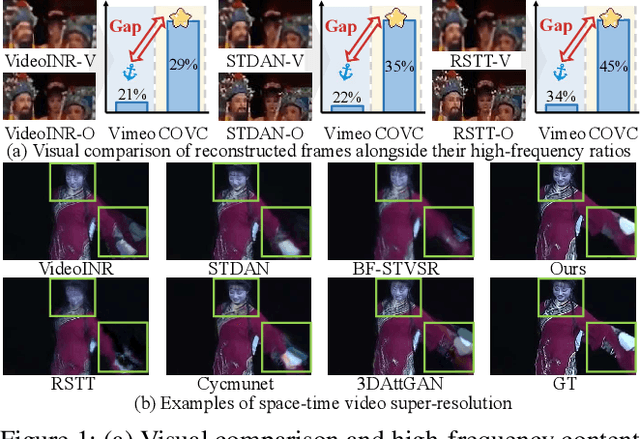


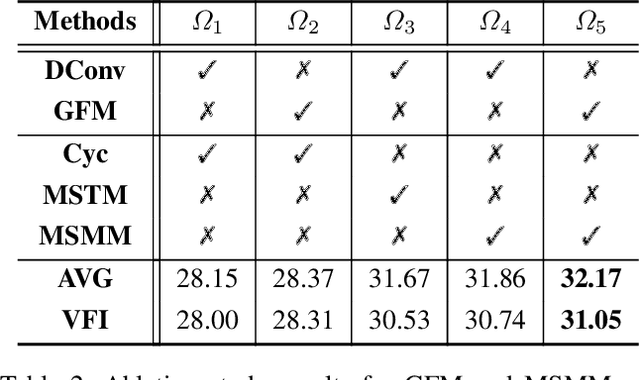
Abstract:Chinese opera is celebrated for preserving classical art. However, early filming equipment limitations have degraded videos of last-century performances by renowned artists (e.g., low frame rates and resolution), hindering archival efforts. Although space-time video super-resolution (STVSR) has advanced significantly, applying it directly to opera videos remains challenging. The scarcity of datasets impedes the recovery of high frequency details, and existing STVSR methods lack global modeling capabilities, compromising visual quality when handling opera's characteristic large motions. To address these challenges, we pioneer a large scale Chinese Opera Video Clip (COVC) dataset and propose the Mamba-based multiscale fusion network for space-time Opera Video Super-Resolution (MambaOVSR). Specifically, MambaOVSR involves three novel components: the Global Fusion Module (GFM) for motion modeling through a multiscale alternating scanning mechanism, and the Multiscale Synergistic Mamba Module (MSMM) for alignment across different sequence lengths. Additionally, our MambaVR block resolves feature artifacts and positional information loss during alignment. Experimental results on the COVC dataset show that MambaOVSR significantly outperforms the SOTA STVSR method by an average of 1.86 dB in terms of PSNR. Dataset and Code will be publicly released.
Plug-and-play Diffusion Models for Image Compressive Sensing with Data Consistency Projection
Sep 11, 2025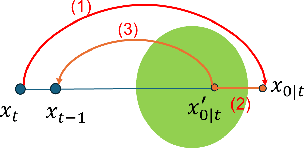
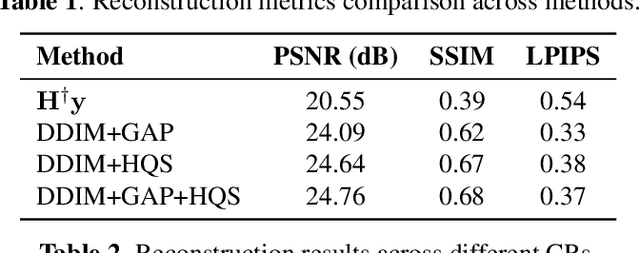
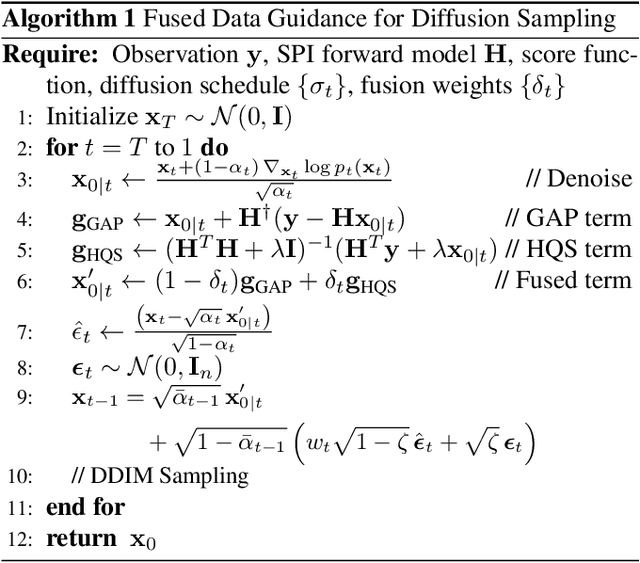
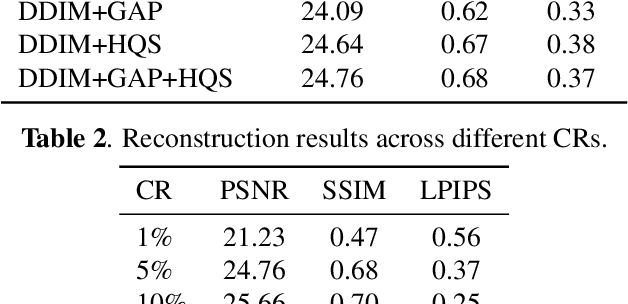
Abstract:We explore the connection between Plug-and-Play (PnP) methods and Denoising Diffusion Implicit Models (DDIM) for solving ill-posed inverse problems, with a focus on single-pixel imaging. We begin by identifying key distinctions between PnP and diffusion models-particularly in their denoising mechanisms and sampling procedures. By decoupling the diffusion process into three interpretable stages: denoising, data consistency enforcement, and sampling, we provide a unified framework that integrates learned priors with physical forward models in a principled manner. Building upon this insight, we propose a hybrid data-consistency module that linearly combines multiple PnP-style fidelity terms. This hybrid correction is applied directly to the denoised estimate, improving measurement consistency without disrupting the diffusion sampling trajectory. Experimental results on single-pixel imaging tasks demonstrate that our method achieves better reconstruction quality.
Texture-aware Intrinsic Image Decomposition with Model- and Learning-based Priors
Sep 11, 2025Abstract:This paper aims to recover the intrinsic reflectance layer and shading layer given a single image. Though this intrinsic image decomposition problem has been studied for decades, it remains a significant challenge in cases of complex scenes, i.e. spatially-varying lighting effect and rich textures. In this paper, we propose a novel method for handling severe lighting and rich textures in intrinsic image decomposition, which enables to produce high-quality intrinsic images for real-world images. Specifically, we observe that previous learning-based methods tend to produce texture-less and over-smoothing intrinsic images, which can be used to infer the lighting and texture information given a RGB image. In this way, we design a texture-guided regularization term and formulate the decomposition problem into an optimization framework, to separate the material textures and lighting effect. We demonstrate that combining the novel texture-aware prior can produce superior results to existing approaches.
Sparse Transformer for Ultra-sparse Sampled Video Compressive Sensing
Sep 10, 2025Abstract:Digital cameras consume ~0.1 microjoule per pixel to capture and encode video, resulting in a power usage of ~20W for a 4K sensor operating at 30 fps. Imagining gigapixel cameras operating at 100-1000 fps, the current processing model is unsustainable. To address this, physical layer compressive measurement has been proposed to reduce power consumption per pixel by 10-100X. Video Snapshot Compressive Imaging (SCI) introduces high frequency modulation in the optical sensor layer to increase effective frame rate. A commonly used sampling strategy of video SCI is Random Sampling (RS) where each mask element value is randomly set to be 0 or 1. Similarly, image inpainting (I2P) has demonstrated that images can be recovered from a fraction of the image pixels. Inspired by I2P, we propose Ultra-Sparse Sampling (USS) regime, where at each spatial location, only one sub-frame is set to 1 and all others are set to 0. We then build a Digital Micro-mirror Device (DMD) encoding system to verify the effectiveness of our USS strategy. Ideally, we can decompose the USS measurement into sub-measurements for which we can utilize I2P algorithms to recover high-speed frames. However, due to the mismatch between the DMD and CCD, the USS measurement cannot be perfectly decomposed. To this end, we propose BSTFormer, a sparse TransFormer that utilizes local Block attention, global Sparse attention, and global Temporal attention to exploit the sparsity of the USS measurement. Extensive results on both simulated and real-world data show that our method significantly outperforms all previous state-of-the-art algorithms. Additionally, an essential advantage of the USS strategy is its higher dynamic range than that of the RS strategy. Finally, from the application perspective, the USS strategy is a good choice to implement a complete video SCI system on chip due to its fixed exposure time.
zkUnlearner: A Zero-Knowledge Framework for Verifiable Unlearning with Multi-Granularity and Forgery-Resistance
Sep 08, 2025Abstract:As the demand for exercising the "right to be forgotten" grows, the need for verifiable machine unlearning has become increasingly evident to ensure both transparency and accountability. We present {\em zkUnlearner}, the first zero-knowledge framework for verifiable machine unlearning, specifically designed to support {\em multi-granularity} and {\em forgery-resistance}. First, we propose a general computational model that employs a {\em bit-masking} technique to enable the {\em selectivity} of existing zero-knowledge proofs of training for gradient descent algorithms. This innovation enables not only traditional {\em sample-level} unlearning but also more advanced {\em feature-level} and {\em class-level} unlearning. Our model can be translated to arithmetic circuits, ensuring compatibility with a broad range of zero-knowledge proof systems. Furthermore, our approach overcomes key limitations of existing methods in both efficiency and privacy. Second, forging attacks present a serious threat to the reliability of unlearning. Specifically, in Stochastic Gradient Descent optimization, gradients from unlearned data, or from minibatches containing it, can be forged using alternative data samples or minibatches that exclude it. We propose the first effective strategies to resist state-of-the-art forging attacks. Finally, we benchmark a zkSNARK-based instantiation of our framework and perform comprehensive performance evaluations to validate its practicality.
Unfolding Framework with Complex-Valued Deformable Attention for High-Quality Computer-Generated Hologram Generation
Aug 29, 2025Abstract:Computer-generated holography (CGH) has gained wide attention with deep learning-based algorithms. However, due to its nonlinear and ill-posed nature, challenges remain in achieving accurate and stable reconstruction. Specifically, ($i$) the widely used end-to-end networks treat the reconstruction model as a black box, ignoring underlying physical relationships, which reduces interpretability and flexibility. ($ii$) CNN-based CGH algorithms have limited receptive fields, hindering their ability to capture long-range dependencies and global context. ($iii$) Angular spectrum method (ASM)-based models are constrained to finite near-fields.In this paper, we propose a Deep Unfolding Network (DUN) that decomposes gradient descent into two modules: an adaptive bandwidth-preserving model (ABPM) and a phase-domain complex-valued denoiser (PCD), providing more flexibility. ABPM allows for wider working distances compared to ASM-based methods. At the same time, PCD leverages its complex-valued deformable self-attention module to capture global features and enhance performance, achieving a PSNR over 35 dB. Experiments on simulated and real data show state-of-the-art results.
High-Speed FHD Full-Color Video Computer-Generated Holography
Aug 27, 2025Abstract:Computer-generated holography (CGH) is a promising technology for next-generation displays. However, generating high-speed, high-quality holographic video requires both high frame rate display and efficient computation, but is constrained by two key limitations: ($i$) Learning-based models often produce over-smoothed phases with narrow angular spectra, causing severe color crosstalk in high frame rate full-color displays such as depth-division multiplexing and thus resulting in a trade-off between frame rate and color fidelity. ($ii$) Existing frame-by-frame optimization methods typically optimize frames independently, neglecting spatial-temporal correlations between consecutive frames and leading to computationally inefficient solutions. To overcome these challenges, in this paper, we propose a novel high-speed full-color video CGH generation scheme. First, we introduce Spectrum-Guided Depth Division Multiplexing (SGDDM), which optimizes phase distributions via frequency modulation, enabling high-fidelity full-color display at high frame rates. Second, we present HoloMamba, a lightweight asymmetric Mamba-Unet architecture that explicitly models spatial-temporal correlations across video sequences to enhance reconstruction quality and computational efficiency. Extensive simulated and real-world experiments demonstrate that SGDDM achieves high-fidelity full-color display without compromise in frame rate, while HoloMamba generates FHD (1080p) full-color holographic video at over 260 FPS, more than 2.6$\times$ faster than the prior state-of-the-art Divide-Conquer-and-Merge Strategy.
Efficient Edge LLMs Deployment via HessianAware Quantization and CPU GPU Collaborative
Aug 10, 2025Abstract:With the breakthrough progress of large language models (LLMs) in natural language processing and multimodal tasks, efficiently deploying them on resource-constrained edge devices has become a critical challenge. The Mixture of Experts (MoE) architecture enhances model capacity through sparse activation, but faces two major difficulties in practical deployment: (1) The presence of numerous outliers in activation distributions leads to severe degradation in quantization accuracy for both activations and weights, significantly impairing inference performance; (2) Under limited memory, efficient offloading and collaborative inference of expert modules struggle to balance latency and throughput. To address these issues, this paper proposes an efficient MoE edge deployment scheme based on Hessian-Aware Quantization (HAQ) and CPU-GPU collaborative inference. First, by introducing smoothed Hessian matrix quantization, we achieve joint 8-bit quantization of activations and weights, which significantly alleviates the accuracy loss caused by outliers while ensuring efficient implementation on mainstream hardware. Second, we design an expert-level collaborative offloading and inference mechanism, which, combined with expert activation path statistics, enables efficient deployment and scheduling of expert modules between CPU and GPU, greatly reducing memory footprint and inference latency. Extensive experiments validate the effectiveness of our method on mainstream large models such as the OPT series and Mixtral 8*7B: on datasets like Wikitext2 and C4, the inference accuracy of the low-bit quantized model approaches that of the full-precision model, while GPU memory usage is reduced by about 60%, and inference latency is significantly improved.
 Add to Chrome
Add to Chrome Add to Firefox
Add to Firefox Add to Edge
Add to Edge